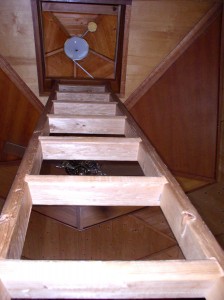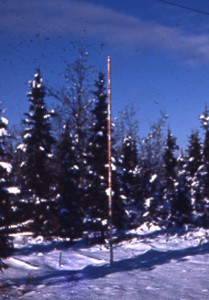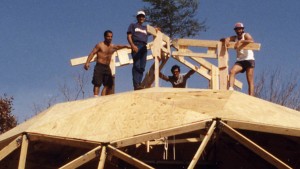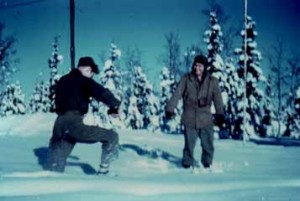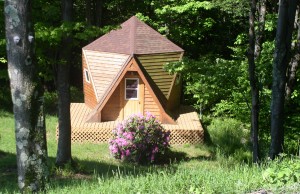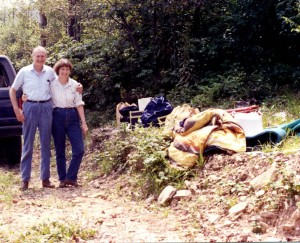Chasing DX: Christmas Joy! (Maybe)
Late Breaking News!
You may remember my previous post where I tried to work Rotuma Island to no avail. Well, I think, maybe, I have finally worked the station!!!
A few days ago I was idly tuning the bands when I came upon a huge pileup in the CW portion of the17 meter band. From spots on the cluster I learned that they were all calling 3D2AG/P on Rotuma.
Now, dear reader, let me outline the state of my station here. First, and most important, I no longer have any skills in Morse code. The Rotuma station is sending at 30 to 35 words per minute. My best code speed is 5 to 10 WPM!!! Even if he does answer my call he cannot slow down to my speed because to do so would completely mix up all the internal settings of his transmitter and keyer. Then, there is the problem that I have no antenna for the 17 meter band. And, on top of that, my power amp only reaches down to 20 meters, so I will have to run the TenTec Omni-6 radio barefoot! That limits my maximum power to 100 watts, instead of the 1200 watts of my power amp.
Conversations on Elevators
Our mountain dome is only two floors, not counting the 4-foot crawl space below or the small cupola on top. The “temporary” wooden ladder (still in place) goes up to that. One side of it has been well marked over the years with the heights of grandchildren and their friends. They climb up and down the ladder quite nimbly. I don’t choose to go up at all anymore, and Mark does only to open and close the windows or to replace a light bulb.
We both go up and down the stairs between the first and second floors dozens of times a day. We considerate it part of our exercise, and besides, it’s the only way to get from one to the other. Fifteen years ago when we designed the house it didn’t seem illogical to have the kitchen upstairs. In fact, we still like the idea. It’s lugging the groceries and packages up that we didn’t consider ahead of time and now have become more and more exhausting. Much of that is our own doing as we go to town, 16 miles away, as infrequently as we can. When we do go, we do every errand possible, including the marketing. Our car is packed, backseat and trunk.
We get home and fill the front hall, then discuss which bags must get upstairs to be put in the freezer or refrigerator and which ones we can carry up later in the day.
A dumb-waiter would do the trick, although I tire of the jokes when I talk about having a “dumb-waiter” in the house. An elevator would be the most perfect answer. We and our bags could all go up together. The fact is there’s no place to install either one.
Alaska Antenna Adventures: Beer Cans and Moose!
My adventures in Alaska were a great introduction to “home brew” construction. Antennas are a big “do it yourself” area. You build it, you adjust it, you re-build it, you make it perfect, and in the next ice storm it comes down!!! That was in 1948. I find myself going through the same cycle today, in 2011.
I remember two antenna adventures from Alaska.
I don’t recall the first wire I put up, or how it was held up at each end. Probably not on trees, as the local pine trees were very short. My KL7OO logbook shows that I had both a 100 ft long wire and a 175 ft collinear zepp antenna. One was fed by an open wire line—two bare conductors held about 6 to 8 inches apart by heavy, ceramic insulators. As I recall, the two wires came through the Quonset hut wall and connected to the send/receive switch before going to the equipment.
One night there was a horrendous crash and the entire building shook. Again and again, it sounded like someone was smashing glass bottles onto our steel Quonset hut roof, or glass insulators!!! Or ceramic open wire line insulators!! The send/receive switch disappeared through the wall of the hut!!! We put on coats and ran outside to see the world champion moose crash through the scrub pine trees trailing wires and smashed insulators from his huge antlers. With each head shake this massive mammal snapped heavy copper wires, and with each lunge he uprooted scrub pine trees until finally he disappeared into the night. We set the alarm clocks an hour early so there would be time to clean up the mess before reveille at 0600.
On another occasion, one weekend in mid December we hams were sitting around the cherry red stove, inventing things, and I was playing with the soldering iron, soldering legs on pennies so Lincoln could stand up.
All of a sudden we all came to the same idea—a Beer Can Antenna!!!
I calculated the length of it, about 16 feet of cans needed to be a half wave on 10 meters or a quarter wave on 20 meters. About 35 cans would do the job. As I recall; Calvin Beets, KL7SD, and another ham went to the local post exchange to get the beer (and more drinkers) And Sergeant Charlie Bellman, W9KMH, went to the Motor Pool, of which he was in charge, and brought back torches and solder.
In those days beer was in steel cans, not this soft aluminum of today. Steel is very easy to solder to. Hold two cans together, apply flux paste, slowly rotate the pair while heating the can junction hot enough to melt solder. Our biggest problem was emptying the cans. Of course, this was 3.2 % beer, only slightly stronger than flavored water. We sat around telling war stories and slowly the stack of cans began to lengthen. By mid afternoon we had the 16 feet.
It was a bright, sunny day with about a foot of snow on the ground, and we easily found a perfect spot to erect our Beer Can antenna. My idea was to mount it on a Coca Cola bottle as a base insulator. Sitting on its base insulator and held in place by three strong ropes our Beer Can antenna was a marvelous sight. By now we had a sizeable group of non-ham “helpers” who promptly saluted our successful erection with the last 6-pack of beer.
The KL7OO logbook shows that our first contact was with Jerry, KL7RE, at Fort Richardson. Then we talked with Toi, KL7CN in Anchorage. Calvin went to Warehouse #3, about a mile away, and helped us tune up the antenna but the band was dead for DX.. A few days later it opened up and I worked W2PEZ, W3KTE, and W4JME and other hams in the New York to Virginia strip. The Beer Can antenna was a huge success.
The Oculus
We designed the inside of our dome as an upside-down house.
The downstairs would be divided up into two bedrooms, a utility room, and a large bathroom. The kitchen and living areas would be upstairs––the small kitchen in the center. Mark’s ham shack would occupy a quarter of the pie, at least as much as would be left after taking a bite out for the kitchen, stairwell, and deck. My little art studio would fit into another piece of the pie, the same size as the ham shack. Another quarter would be our sitting area and the fourth a dining area. The dome structure itself (44 feet in diameter) would rise up and over us. It would cover us––no walls dividing up the upstairs areas––just openness. It would be topped off with a 5-sided cupola.
The cupola seemed like a wise idea. It would give us windows to open to let the hot air escape out in the summer, and cool breezes in. It brought extra light in. Our carpenters built a dropped floor and added a “temporary” wooden ladder so we could go up there and look at the view from all sides and to open and close the windows. It’s also served at times as a sleeping loft for grandchildren.
But I wonder what it would be like if we didn’t have a cupola but had put in an oculus (“eye”) such as they had in the Pantheon in ancient Rome. Its dome was one of the largest ever built back in the early 20’s BCE. It still stands. At the top of its dome is this round oculus which lets a large shaft of light come down inside. The light changes its angle during the course of the year to illuminate various statues all around its interior. This oculus is open to the heavens. Rain and sometimes snow fall down through it and are carried off by drain pipes below the floor.
Alaska 1948: Stove Cold!
That stirs up some memories — thinking of my adventures in Alaska in the late 1940’s. My ham radio station was built in a Quonset hut which I lived in and shared with 3 other guys. This is a sheet steel half tube some 16 ft across and 32 ft long resting on 4 ft steel walls. It was insulated on the inside by ¼ inch composition board nailed to the sheet steel. There was a large door at each end and a heating stove in the middle. Beds, closets, footlockers for each of 4 men filled the building.
In the tropics they did not have a stove and therefore could squeeze 6 or 8 men into a Quonset hut. The stove ran on JP-1 aircraft jet fuel (really just high grade kerosene). We fiddled with the stove to double the flow rate of JP-1 and it ran day and night with the entire structure at a dull red heat. There were two fifty gallon drums just outside our hut that were filled once a week.
Sometimes the oil ran out before the tanker arrived. Whoever woke up first in a cold room immediately woke everyone else. We quickly dressed and put on our Parkas and then flew out of the hut and went screaming up and down the road to the adjacent huts, some 100 to 200 yards away.
Bursting into another, warm, Quonset hut we yelled “STOVE COLD!!!” and wiggled into any space we could find on the floor.
Within minutes everyone was fast asleep.
A serious problem was that the stovepipe filled up with soot very fast. Then the flame could smother and fill the room with carbon monoxide. Very bad!!! We could call the chimney cleaning crew but that would take a week or more. Our chimney cleaner was a Coca Cola bottle filled with JP-1, which I would take up onto the Quonset hut roof. Two men would man fire extinguishers. One would look out for any officers on the road. Then the lookout would yell OK!!! And I would dump the JP-1 down the inside of the stovepipe. Immediately I would curl up in a ball and roll off the roof into the deepest snow. There was a roar that shook the hut and all the soot blew up into the sky, leaving a clean stovepipe and an acre of jet black snow.
The Small Dome
We just closed up the “small dome” for winter. It doesn’t take too much work. We make sure the windows are all shut and locked, that the kitchen sink drain gets blown out, and that anti-freeze is poured into it as well as into the toilet. We sweep up a bit, wipe off the counter and make sure the little refrigerator is closed so no mice get into it. The circuit breakers are then turned off, the door is closed, and out we go.
The small dome was not part of our original building plan. In fact why or when we decided to build a dome for our main house I don’t recall. I had originally fallen in love with the idea of an octagon house. How cool, I thought. I had seen a photo of one built on a beach, and it stuck in my mind as something that would be fun to build and to live in––crazy walls jutting out making odd-shaped rooms, and then trying to fit furniture into them. We talked about that among other ideas, but soon the octagon shape melted and oozed into the shape of a dome.
And a geodesic dome it would be.
The Ups and Downs of Sunspot Cycles
The good news is that the 10 meter band is wide open. The bad news is that I have low power (100 watts) on 10 meters and no antenna. Wait! Wait! The good news is that my vertical antenna for the 40 meter band loads up swell on 10 meters. And you can go around the world with low power on the ten meter band when it is open. All of a sudden, I get the feeling I have been here before!!!
In 1948 I was in the US Army Signal Corps, in Alaska and I got my ham radio license in April of that year. I got the call KL7OO. Since I was working at the Signal Corp Depot, I had access to all sorts of radio equipment. The station I put together had a Hallicrafters HT-9 transmitter and the receiver was a Hammarlund Super Pro . This gave me about 100 watts into a long wire antenna. The HT-9 was crystal controlled and used plug-in coils in little tin cans to change bands and frequency.
I started my ham radio activity on 40 meters CW and worked stations all over the Pacific and Asia. That winter I found that on the 10 meter band I could reach New York City almost any day of the week. I talked with NYC hams and had them phone my mother, in Brooklyn. I thought that ham radio would always be like this!
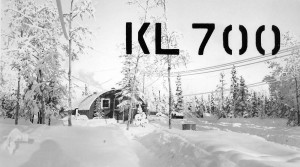 Well, the eleven year sunspot cycle was at a peak when I was in Alaska and a few years later it was at a minimum. The 10 meter band was absolutely dead for about five years. And so it has been over the years — hot, dead, hot, dead. Then, last cycle the old man sun pulled out another card; a double minimum. Year after year there were no sunspots at all. 10 meters was dead and dead and dead.
Well, the eleven year sunspot cycle was at a peak when I was in Alaska and a few years later it was at a minimum. The 10 meter band was absolutely dead for about five years. And so it has been over the years — hot, dead, hot, dead. Then, last cycle the old man sun pulled out another card; a double minimum. Year after year there were no sunspots at all. 10 meters was dead and dead and dead.
So, now the good news is that the sunspots are back and 10 meters is showing some life. A few days ago I worked into Russia, Ukraine, Andorra, Croatia and a mess of Europeans. Happy days are here again!!!
The Land Has Spoken
After we bought our property we still had no idea what type of house we’d build. We’d speak of the “mountain house”, but with no grand vision of how it would look, or how big it would be. It would just be for get-aways and therefore probably a fairly small place. Nothing fancy. After all, we still had our apartment in Arlington; there was no plan to leave it back then.
Maybe if we spent some time on the mountain––a weekend here and there––we could walk the property. It might help us visualize what type of house would be best and where we should place it. The land might “speak to us”––give us a feel for the right kind of house and where it would be situated.
Unfortunately we couldn’t even get to our property on our own. Not with our Honda CRX. We’d have to park it down on a lower road, and Ken, the owner of the mountain property, would load our food, clothing and supplies into his 4-wheel drive vehicle. Up and over the rugged old logging road we’d go, another two miles from our car. He’d drop the gear by the side of the road and leave. We were there, totally alone, in the forest, on the mountaintop.
Read the rest of this entry »
Putting the “human” back into human interfaces
In the latest QST, Frank Columbus, WA2KWR, writes the following:
“— I find the current lot of handheld and mobile Amateur Radios to be overly complex.”
Frank goes on for a page describing the failure of modern radios to provide a workable human interface. His words echo mine of a decade or so ago. Those who design these multi-menu-messes argue “Look at all the features! You never had it so good!” Well, I don’t want infinite features, I want easily understood, easily implemented functionality.
Way back in the early days of television there was a man called “Madman Muntz” who advertised that his TVs were the best because he featured “One Knob Picture Control!” He was brilliant, but 50 years behind the technology to do it well. It took Steve Jobs to use modern technology to create a truly modern human interface to Apple’s products.
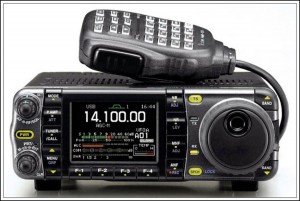 I thought of this while struggling to install a DVR to work with my Satelite TV. And, again, when I tried and failed to install my new ICOM 706MKIIG with my homebrew Power Amp and my ancient TELREX 20m YAGI. Eventually I got the DVR working, tho now I have three remotes to search for whenever I want to change something. The ICOM is still on the workbench connected to a dummy load.
I thought of this while struggling to install a DVR to work with my Satelite TV. And, again, when I tried and failed to install my new ICOM 706MKIIG with my homebrew Power Amp and my ancient TELREX 20m YAGI. Eventually I got the DVR working, tho now I have three remotes to search for whenever I want to change something. The ICOM is still on the workbench connected to a dummy load.
Some very many years ago I organized a conference on Speech Recognition at which IBM gave a good explanation of the problems they were encountering in trying to replace the “Typist” with a computer. It had to do with “entropy” and the bottom line was that the computer would have to contain the entire language, grammar and slang and all, in order to truly translate each spoken word into bits.
Human Engineering!!! ICOM interface vs Apple’s. How long does it take you to find a DX on the Cluster and go to that band and frequency and that split, and set the correct PA Drive and tuning? We need a new spec and measure of Human Interfacing!!!
The Best of Plans
Mark and I had often talked about our future plans way back before retirement days were near. The conversations often cropped up after a Friday night at the National Geographic lectures in the DAR Constitution Hall, followed by dinner at Freddie’s Piano Restaurant. Freddie’s was on Connecticut Avenue, a small place always filled with returning, dedicated diners.
Buster would play his piano non-stop and we’d linger over our meal, talk of our kids, our near and far goals and plans, and our enjoyment of the evening. (Unfortunately, Freddie’s is no longer there. The building was torn down years ago and replaced with a larger business building.)
After our meal and before driving home we’d take a half hour to walk along the sidewalk, often going into the beautiful lobby of the Mayflower Hotel and going out the other side. We’d resume our walk and now and then would stop to talk with the men who were building the new metro system. “It’s beautiful down there!” they would exclaim. We couldn’t wait to see it.


